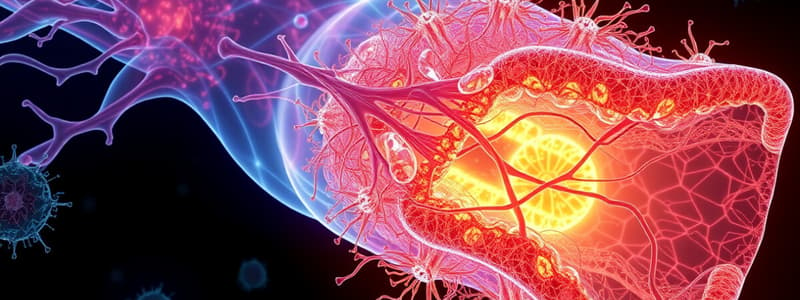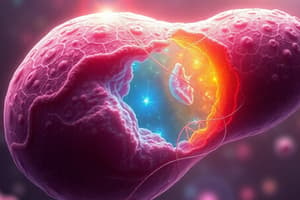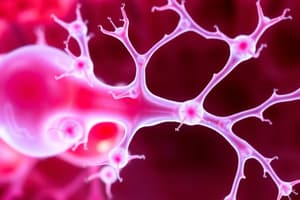Podcast
Questions and Answers
At what stage of development does the spinal cord extend the entire length of the embryo?
At what stage of development does the spinal cord extend the entire length of the embryo?
- Second month
- At birth
- Third month (correct)
- Fifth month
At the 24th week of gestation, where does the lower part of the spinal cord end?
At the 24th week of gestation, where does the lower part of the spinal cord end?
- L1 Vertebrae
- S2 Vertebrae
- L3 Vertebrae
- S1 Vertebrae (correct)
What is the fate of the lower part of the spinal cord at birth?
What is the fate of the lower part of the spinal cord at birth?
- Ends at L3 Vertebrae (correct)
- Ends at L5 Vertebrae
- Ends at S1 Vertebrae
- Ends at L1 Vertebrae
Which part of the neural tube is the brain an enlarged version of?
Which part of the neural tube is the brain an enlarged version of?
Which of the following brain structures is a direct continuation of the spinal cord?
Which of the following brain structures is a direct continuation of the spinal cord?
Which secondary brain vesicle develops into the pons?
Which secondary brain vesicle develops into the pons?
Which part of brain differentiation reflects almost none of the basic pattern?
Which part of brain differentiation reflects almost none of the basic pattern?
What are the distinct plates present in the brainstem?
What are the distinct plates present in the brainstem?
What is the primary role of spongioblasts in spinal cord development?
What is the primary role of spongioblasts in spinal cord development?
In spinal cord development, where do neuroblasts migrate to?
In spinal cord development, where do neuroblasts migrate to?
According to the classical theory, what do remaining matrix cells differentiate into after histogenesis?
According to the classical theory, what do remaining matrix cells differentiate into after histogenesis?
What type of cells form a pseudostratified neuroepithelium during spinal cord development?
What type of cells form a pseudostratified neuroepithelium during spinal cord development?
What happens to some central processes of the dorsal root ganglia (DRG) during spinal cord development?
What happens to some central processes of the dorsal root ganglia (DRG) during spinal cord development?
Which zone of the developing spinal cord is expected to become the future gray matter?
Which zone of the developing spinal cord is expected to become the future gray matter?
What reflects different phases of development in the pseudostratified neuroepithelium?
What reflects different phases of development in the pseudostratified neuroepithelium?
What forms as the spinal cord develops from the neural tube?
What forms as the spinal cord develops from the neural tube?
What is the primary effect of the Pontine Flexure on the Rhombencephalon?
What is the primary effect of the Pontine Flexure on the Rhombencephalon?
Which statement accurately describes the outcome of folding in brain development?
Which statement accurately describes the outcome of folding in brain development?
What is the significance of the Median Foramina of Magendie in brain development?
What is the significance of the Median Foramina of Magendie in brain development?
Which of the following best describes the role of the Alar Laminae during the formation of the brain flexures?
Which of the following best describes the role of the Alar Laminae during the formation of the brain flexures?
How does the folding during embryologic development affect the structure of the brain?
How does the folding during embryologic development affect the structure of the brain?
Which of the following tissues are derived from neural crest cells?
Which of the following tissues are derived from neural crest cells?
What is one of the clinical correlations associated with defective neural tube development?
What is one of the clinical correlations associated with defective neural tube development?
Which of the following differentiates directly from neural crest cells?
Which of the following differentiates directly from neural crest cells?
Which cells are NOT typically formed from neural crest cell differentiation?
Which cells are NOT typically formed from neural crest cell differentiation?
Ectodermal placodes arise from which type of ectoderm?
Ectodermal placodes arise from which type of ectoderm?
What structural defect is associated with anencephaly?
What structural defect is associated with anencephaly?
Which of the following is NOT a function of neural crest cells?
Which of the following is NOT a function of neural crest cells?
Which of the following is a notable feature of brain development in cases of anencephaly?
Which of the following is a notable feature of brain development in cases of anencephaly?
What is the origin of all motor nuclei in the brainstem?
What is the origin of all motor nuclei in the brainstem?
What is a primary characteristic of pheochromocytomas?
What is a primary characteristic of pheochromocytomas?
During which stage of development does mitotic activity within neural tissue complete?
During which stage of development does mitotic activity within neural tissue complete?
Which of the following statements about neuron development is true?
Which of the following statements about neuron development is true?
Where do most pheochromocytomas occur?
Where do most pheochromocytomas occur?
Which type of sensory nucleus is derived from the alar plate?
Which type of sensory nucleus is derived from the alar plate?
What symptoms are associated with pheochromocytomas due to excess catecholamines?
What symptoms are associated with pheochromocytomas due to excess catecholamines?
How does the nervous system develop after prenatal development?
How does the nervous system develop after prenatal development?
Flashcards are hidden until you start studying
Study Notes
Neural Crest Cells Differentiation
- Neural crest cells migrate and differentiate into various tissues and organs throughout the body.
- They contribute to the formation of several structures:
- Dorsal root ganglia (DRG) cells
- Sensory ganglia of cranial nerves (CN)
- Autonomic ganglia
- Adrenal medulla
- Chromaffin tissue
- Melanocytes
- Schwann cells
Clinical Correlation: Anencephaly
- Anencephaly is associated with failure of the cephalic neural tube to close, leading to severe developmental defects.
- It results in the absence of the vault of the skull and degeneration of brain tissue.
Formation of Ectodermal Placodes
- Ectodermal placodes arise from the common panplacodal ectoderm, surrounding the anterior neural plate and neural crest.
- Differentiation of placodes leads to diverse developmental fates, including spongioblasts that become neuroglial cells.
- Neuroblasts migrate to the mantle zone and form the gray matter of the spinal cord, while their axons enter the marginal zone, forming white matter.
Development of the Spinal Cord
- The spinal cord develops from the elongated caudal part of the neural tube.
- Spinal nerves exit the tube obliquely, reaching the intervertebral foramina by the third month of development.
- By the 24th week, the vertebral column grows faster than the spinal cord, resulting in the lower cord ending at the S1 vertebra.
- At birth, the lower cord reaches the L3 vertebra, while in adults, it terminates at the level of L1-L2.
Development of the Brain
- The brain develops from the enlarged cranial segment of the neural tube, initially splitting into various parts:
- Brainstem, with distinct motor and sensory plates:
- Myelencephalon giving rise to the medulla
- Metencephalon forming the pons
- Mesencephalon as the midbrain
- Brainstem, with distinct motor and sensory plates:
- Higher brain centers exhibit different patterns compared to the basic structure of the brainstem.
Brain Flexures
- The primitive brain features three main flexures during development:
- Pontine flexure located at the middle of the rhombencephalon (hindbrain).
- The folding leads to:
- Flattening of the rhombencephalon and a buckling effect.
- Displacement of the alar laminae lateral to the basal laminae.
Clinical Correlates
- Motor nuclei in the brainstem arise from the basal plate, whereas sensory nuclei are derived from the alar plate.
- Mitotic activity in neural tissue concludes during prenatal development, meaning individuals are born with a predefined number of neurons.
- Postnatal growth and specialization of nervous tissue continue, particularly in the early years of life.
Pheochromocytomas
- Rare tumors originating from chromaffin cells can cause excessive release of epinephrine and norepinephrine.
- Symptoms include episodes of hypertension, increased heart rate, and headaches.
- Most tumors occur in the adrenal medulla, with around 10% found in other abdominal sites.
Studying That Suits You
Use AI to generate personalized quizzes and flashcards to suit your learning preferences.



